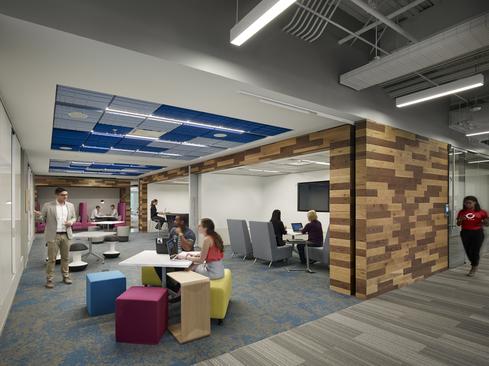Capital One: Think Like A Designer, Work Like A StartupCapital One: Think Like A Designer, Work Like A Startup
The creation of Capital One Wallet is an example of how a large financial services IT organization can move like a startup and think like a design firm, transforming business expectations in the process. Their work earned them the No. 1 spot in the 2016 information Elite 100.

10 Programming Languages That Will Keep You Employed
10 Programming Languages That Will Keep You Employed (Click image for larger view and slideshow.)
When you think "tech startup," a financial institution that's nearly 30 years old and employs 40,000 people is hardly what springs to mind. Yet a startup culture is exactly what Capital One Financial is cultivating in its approach to tech advances such as the Capital One Wallet mobile app.
That's only one way the financial institution is breaking the mold in its industry. Capital One Financial has also embraced Design Thinking, a groundbreaking approach for developing goods and services. The company sends executives to Stanford University's Hasso Plattner Institute of Design for training, and then incorporates the methodology throughout the organization.
"Fundamentally, our products are customers' experiences that are principally distributed through software," said Rob Alexander, CIO of Capital One Financial, in an interview with information. Recognizing that helped the organization focus on building software that could leverage the data and analytics about its customer relationships and -- most importantly -- place these skill sets right alongside marketing, customer relationship management, and brand-building as crucial elements in the company's strategy.
"With that understanding, we embarked on a shift from IT to technology," said Alexander. "Over the course of this transformation, we rebranded ourselves from the IT department to Capital One Technology."
Figure 1:
To help close the gender gap in science, technology, engineering, and mathematics education, Capital One created C1 Coders, a 10-week coding curriculum for middle school students. Led by Capital One volunteers, it gives hundreds of students exposure to software engineering principles and practices. The students have the opportunity to get hands-on experience learning software development, problem-solving, and even developing their own app.
(Photo Credit: Capital One)
A typical bank organization will largely procure third-party software for its internal and customer-facing operations, Alexander said. Capital One, on the other hand, is "an organization that truly builds its own software and develops its own solutions. That is a different DNA," he said.
Capital One Wallet can be seen as a microcosm of this transformation. "It reflects how we operate today, [which] is very different from how a typical bank operates," Alexander said.
The Startup Mentality
To hear Alexander describe what that looks like at Capital One is an exercise in cognitive dissonance. You know you're talking to the CIO of a large financial institution, but the words he uses sound more like the eager story of a Silicon Valley startup:
We are hyper-focused on how we can get more productive, move quicker, get things to market faster, and constantly iterate.
We build on the public cloud, leveraging continuous integration and delivery methods to deploy our products into production.
We focus on iterative delivery, so we are constantly improving on process.
We're an open source-first organization. We build on open source, and we give back to the open source community.
We build using microservices architecture and restful APIs.
All of these factors came to bear in the creation of Capital One Wallet. "We built Capital One Wallet entirely native, first for iOS, then Android," Alexander said. "We were first to have a wallet app with Android tap-to-pay incorporated into the app, and we did it all in under nine months."
Capital One Wallet is designed to help customers track spending. It flags potential fraudulent activity through real-time alerts sent when either a physical credit/debit card or Apple Pay or Android Pay is used. Customers can see a running list of their transactions, which -- unlike traditional banking apps -- instantly displays enhanced information, such as the true merchant identity, location, and contact information.
The app also gives customers the ability to instantly redeem rewards points for digital gift cards, apply them to past travel charged to their credit card, or use them to pay off a statement. It also included Apple Touch ID as part of the initial launch.
The app offers either Touch ID or SureSwipe, which uses a customized nine-dot pattern sign-in, rather than a standard user name and password. The Capital One Wallet uses a different identifier than the physical plastic credit/debit card, so there's no need to cancel the card if the phone is lost, and vice versa.
In addition to the iOS Capital One Wallet, the company released capabilities to integrate with the Apple Watch. Capital One Wallet for Android devices is also one of the first mobile tap-and-pay solutions in the US to use host card emulation, which is Android's equivalent of Apple Pay.
Collaboration and Conversation
Collaboration among various stakeholders was a key element in the development of the Capital One Wallet -- and the company's ongoing design practices.
The project began with a series of design sessions intended to uncover the unarticulated needs of customers and define a problem that needed solving. Involved in the design sessions were associates from Capital One Technology and Digital, as well as business associates from the company's bank and credit card businesses.
Scott Totman, head engineer on the Capital One Wallet project, joined the company three and a half years ago. He was one of the professionals selected to attend classes at the Stanford University Institute of Design.
"What I learned coming out of it is that you're not asking the customer what the next feature is that they'd like to see," Totman said. "You're asking the customer to tell you a story about their relationship with financial services and money. You listen for pain points, purchasing points, and the customer,
Page 2: The challenge of real-time
through their story, is educating you on these insights so you can help solve the problems that they're experiencing and describing."
Figure 2: 
Capital One workspaces are designed to drive innovation and enable associates to work the way they work best. This meet-up space on the company's Virginia campus is designed with modern tech teams in mind, with reconfigurable furniture, integrated whiteboards, and content-sharing technology.
(Image: Capital One)
These customer conversations are ongoing, but prior to the development of Capital One Wallet, they focused on purchasing experiences, and the team used that information to come up with features based on these customer stories. "Once we launched, we could completely change the conversation and ask them more direct questions around their experience with the app in order to optimize it and make it better," Totman said.
Since then, Alexander said, business leaders across the organization "are lining up to do their work in agile teams, and put the folks on their teams into our agile organization."
The Real-Time Challenge
One of the challenges in creating Capital One Wallet was moving from a batch process to a near real-time approach. "Banking is inherently a batch world," Alexander said. "Banks did a bunch of transactions during the day, processed overnight, and started the next day with a clean slate. Consumer expectations are real-time. One of things we're really focused on is, how do you make these interactions truly real-time for the customers? How do you engineer solutions for systems that [didn't] start as real-time systems?"
Totman noted that the environment at Capital One is a mix of legacy technology and new, open source capabilities.
The Capital One Wallet project relies on APIs to communicate with backend systems. "Without those, this project would have been difficult," Totman said. "Once we understood which systems would be hit, we were able to plan our API roadmap to make sure those capabilities were coming online at the right time."
The financial services industry is one that spends heavily on technology, Alexander said. "There's a heavy investment in running the engine, keeping the lights on, business as usual. There's heavy investment in regulatory requirements. Then, on top of that, you have to invest in innovation."
Factor in the challenge of integrating systems that are introduced through acquisitions, and it can make for a tricky combination. In recent years, Capital One has acquired three medium-sized banks, as well as ING Direct and HSBC's US credit card business.
"Every time we do these acquisitions, we put investment into integrating those systems fully and consolidate them," Alexander said. "When you acquire one more bank, how do you take all those accounts, all those deposits and loans, and put them on one platform?
We've stayed ahead of that sprawl, and we make sure we continue to invest in reducing the number of platforms we have. We've focused on rationalizing and simplifying our infrastructure … while also investing in new capabilities."
Security is another priority. It is such an important factor for an organization like Capital One that it almost goes without mentioning. "Customer information is our most precious asset," Alexander explained. "We engineer security first into every application and every facet of our infrastructure that serves those customers."
Moving Forward
So what's ahead for Capital One? The company recently rolled out CardLock, which enables customers to turn off their Capital One plastic cards via the Wallet app. "If your card is lost or stolen, you can prevent fraud from happening on your card just by turning it off," Alexander said.
Another new feature is what Capital One calls Second Look -- a different kind of alert system that helps identify possible mistakes or unexpected charges, such as duplicate charges or increases in monthly bills. "We're constantly applying data analytics to your stream of transactions and alerting you to things that look unusual," Alexander explained.
Most recently, the company has rolled out card servicing using Amazon Echo and its Alexa voice-activated artificial intelligence service. "You can talk to Capital One and service your card account through Alexa," Alexander said. "It's indicative of our belief that banking is becoming more integrated into people's lives."
The company also recently announced a developer platform that takes APIs developed for internal use and exposes them to third-party developers. "This enables us to let third-party developers integrate Capital One into their products," Alexander said. "We think that's really exciting."
Machine learning is also playing a significant role in Capital One's future plans. "Machine learning will be a huge area of innovation within the banking industry," Alexander said. "Banking is a rich environment in terms of the amount of data, the amount of interactions with customers, and the complexity of products and services you have. It's ripe for doing it better, and machine learning delivers tools to provide more tailored, customized products for your customers."
The new way of operating, Alexander said, "is a comprehensive shift across our company that is really embedding digital capabilities across the organization." The biggest challenge in the company's transformation was not technical. "The biggest challenge is the talent shift and crossing the chasm from being a traditional IT organization," Alexander said. That's not all, he added. "The most fundamental message here is that it starts with great talent. Once you expose your business customers to that great engineering talent and what IT can deliver, they see their ideas become reality."
Add in an operating model that's about agile, public cloud, and an architectural approach based on APIs, and business executives become addicted. "They see the power of what engineering can deliver," Alexander said. "You see success in the market, and it feeds on itself. That's the thing that is at the heart of what we've done. It's an operating model that empowers us to move quickly, be creative, and innovate."
About the Author
You May Also Like






